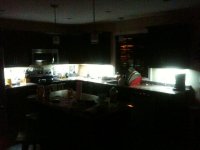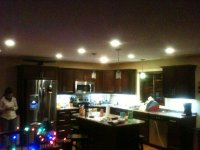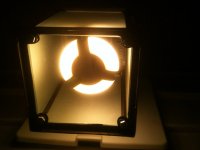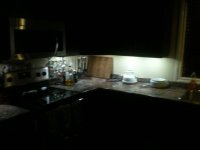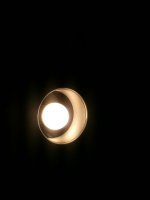Here's some basic info to get started, the questions people often ask me. I work in solar power in the USA.
TERMS AND DEFINITIONS:
You need to understand the basic terms for energy and power to even understand the specifications of a solar electricity system. If you're an E-S forum regular you already do! But for anyone who's just joining us, I will try to make this as simple as possible, and you try not to let your eyes glaze over cuz the good stuff is coming:
Volts (V) = Electrical potential. I think of it like a "virtual" vertical distance from the top of a hill to the bottom of the hill. Um, don't worry if you don't understand voltage all that well, though, just try and understand how it fits in.
Amperes/Amps (A) = Electrical current. The rate of electrical flow, as through a wire.
Watts (W) = "Power". Basically, power is Volts times Amps (W = V x A). You have to have current flowing and an electrical potential, then you have "Power". Let's say you want a motor to go faster - you might be able to do this by increasing the Volts or the Amps, thus increasing the amount of power the motor was using.
AC,
DC,
Resistive, Inductive, and Capacitive Loads and
Power Factor (PF) = Just kidding, I'm not going to try to summarize this stuff in a sentence, I don't want to start any flamewars with physicists :lol:
Watt-hours or Kilowatt-hours (Wh/kWh) = "Energy". Power times Time. This is the quantity you use and pay the electric company for. If you have a motor consuming 1000 Watts (1 kW/kilowatt) of "Power" AND you leave it on for one hour, then the TOTAL AMOUNT of "Energy" you have consumed is 1000 Watt-hours (Wh) which is 1 kilowatt-hour (kWh).
$ = "Money" which is one really good reason to get some of your electricity from the sun and pay the power company less.

Here in the USA energy cost is represented as $/kWh. Lots of folks are paying somewhere around $0.15/kWh, but this varies a lot across the nation. People who use more than average amount of energy may be paying higher tiered pricing of $0.45/kWh or more.
THE SUN:
The sun provides energy in the form of light and heat. In the middle of a perfectly clear summer day, the sun casts about 1000 Watts of "power" per square meter of surface on which that light is falling. The amount of power varies a lot with cloud cover and the angle the sun is cutting through the atmosphere. In the middle of the summer you might expect the equivalent of 4-6 hours of "full sunlight."
Also, the sun is at very different places in the sky at different times of the day and year, so it is hitting your roof (and your solar panels) at a different angle. When the sun is shining sort of "sideways" to a panel, the panel is receiving less sunlight than when the sun is directly above it.
The idea of any kind of solar power is to convert some sunlight into usable energy. People in very cold climates with a black roof are using some of that power to help heat the house. Other ways to use that solar energy are to heat water, or convert the light into electricity and power your appliances etc.
HOME SOLAR ELECTRICITY:
Most home solar electricity systems today are "grid-tied photovoltaic systems". "Photovoltaic" means electricity from light. "Grid-tied" means you still get your electricity from the power grid, but when the sun is out, you also get electricity from solar panels. And if you generate more than you use, your system will "backfeed" and you will get credits from the utility company.
Even though many home users pay a flat rate for their energy, it's actually generally more expensive during the day when air-conditioners and factories and stores are all running. For home users who don't need much energy during the day, this is great. You can typically set up your utility company to bill you on a "time-of-use" schedule... Now your nighttime energy will be cheaper, and your daytime energy more expensive. Except because you have solar electricity, now during the day your solar system is actually
generating credits at the higher daytime value. 8)
There are two basic conceptual parts to a grid-tied solar system: The photovoltaic modules and the inverter. The modules generate DC power at one voltage, and the inverter outputs AC power at a different voltage, plus it synchronizes its AC output with the power grid so that it can smoothly feed that power back out onto the grid. (more on these below)
If you are on the power grid, unless you have major reliability problems with your electric power, for most folks it makes the most sense to get a grid-tied solar electric system. This is because they are cheaper than off-grid systems, and you don't need to install/maintain/replace your batteries, and you can still get very close to zero payment to the utility if you get your system & usage just right. But for remote locations/etc, you can also go "off the grid". More on that below.
SOLAR WATER HEATING:
Aside from generating electricity, solar power can also be used to heat water directly, and this is actually a really efficient thing to do also. The idea is that instead of feeding cold water into your water heater, you feed in pre-warmed water. Now your water heater does a lot less work to provide hot water, and reduces energy costs.
In many climates, solar water heating is a really good way to save money. And compared to solar electricity systems, it has the advantage for some people of being much more DIY-friendly! Very few people would be able to build a grid-tied solar inverter and solar modules in their workshop (and you'd have a hard time getting it to pass city inspection if you did). But there are many people who have put together workable solar water pre-heating systems from recycled/re-purposed stuff, with cash outlay very close to $0.
Most of the stuff I'm talking about here is about solar electricity systems, but some of it applies to solar water heating too. Although I don't deal with solar water heating myself, I do think it's something good to consider as another way to save energy and money.
THE MOUNTING PLANE:
The angle matters. In the northern hemisphere, solar panels should ideally be facing south. The tilt should be at least 5 degrees or so, not flat - this helps rain water run off the panels and they will stay cleaner. In areas where there is snow, the tilt should ideally be steep so that snow will come off more quickly. The azimuth (compass direction) and tilt of your panels determine how much sunlight they will receive on average, assuming there is no shade.
You can use computer modeling tools to estimate how much electricity a photovoltaic system will generate at various times of year, given the location and the tilt and azimuth of the modules. These tools use the angle of the sun plus historical weather averages to figure out how much energy you'll get. One simple free tool is called
PVWatts (version 1).
If installing on a roof, it's best to install on a new roof or one that won't need to be replaced for a few years. Structurally, it's important that the roof be able to support not only the extra weight of the solar, as well as lifting from wind blowing under the panels. Lots of rack options are available but be warned, getting up there and punching holes in your roof is not for the faint of heart...
SHADE:
Shade is really bad for solar systems. In the case of solar electric systems it's even worse. Sometimes just a little bit of shade on one corner of a module can cause a whole module or a whole string of modules to reduce output by 90%. So the best thing is to mount modules where they will not get any shade, or at least they will only get shade in the early morning and late afternoon, and/or in the winter when the sun is lower. It's important to KNOW how much shade a given spot is going to get all year round. Any solar installation company can come out and do an audit of your roof and tell you the good spots for solar, or if you want to audit yourself this is
also possible.
PHOTOVOLTAIC MODULES:
Solar panels that produce electricity are called Photovoltaic or PV modules. Typically a module consists of a series/parallel array of individual solar cells, covered in glass. The cells may be made from slices of silicon crystals or from films created in different ways.
PV modules are a source of voltage and current, but they don't quite act like batteries. They have a characteristic
current-voltage relationship when light is shining on them. If you leave them open circuit, they will sit at "open circuit voltage" but obviously no current will pass. Conversely, if you short circuit a panel to itself you will get obviously no voltage, but "short circuit current" will pass through them. There is a sweet spot called the "Max Power Point" where the load on the panel creates the most Power (where Voltage and Current are both pretty high). The Max Power Point changes as the amount of light hitting the panel changes, and as the temperature changes.
Temperature is important for PV modules. As the cells in the module get hotter, the voltage goes down, and the power along with it. Different modules have different levels of temperature response, and this can be rated in Volts per degree Celsius. But for all modules it's good to have some passive cooling. Wind and airflow underneath the modules helps; modules that are mounted very close down to the roof will get hotter.
Modules are rated in
STC or PTC Watts. This is the theoretical maximum you'd see them generate in perfect conditions. Just because you have 1000 Watts of solar panels doesn't mean you'll be generating 1000 Watts of electricity all the time. That amount is reduced by your angle to the sun, dirt on the panels, hot panels, wiring losses, inverter inefficiency, etc.
GRID-TIED INVERTERS:
You can think of the grid-tied inverter as really three things, logically:
(1) a Max Power Point Tracker (MPPT) that varies the load on the PV array to achieve maximum power point
(2) a voltage converter to stabilize/convert the varying input voltage
(3) an inverter that converts the DC into AC and also synchronizes the AC waveform with the grid
Most of the time for home setups you will have one inverter connected to an array of modules. There are also "microinverters" where you install one inverter per panel or per two panels, and "remote" systems where you have a bunch of little MPPTs and voltage converters connected to separate panels or strings, but still only one central inverter.
Grid tied inverters are generally rated in AC Watts (output). This means that it isn't unusual to have 5,500 or 6,000 Watts of modules connected to a 5,000 Watt inverter. They also have efficiency ratings and some are a couple percent more efficient than others.
Grid-tied inverters do not work during power outages. You would need to also have a separate battery system if you want to maintain power during grid outages.
OFF-GRID: CHARGERS AND BATTERIES AND INVERTERS
You can't really run appliances directly off of a solar panel. Okay, you sort of can, like cooling fans and stuff. But normally when we're thinking off-grid solar, what that means is that you are running everything off of batteries, and using solar to charge your batteries.
Instead of a grid-tied solar inverter, you need a solar battery charger. Any decent solar battery charger consists of:
(1) a Max Power Point Tracker
(2) a voltage converter
(3) a charge controller (to take good care of your batteries)
Unlike with wind and other systems, you don't need to worry about what to do with excess energy once your batteries are full. The charger can just get as much or as little energy from the modules as it needs.
Once you have batteries and a charger, you can either run DC lights and appliances directly off the batteries, or you can use a regular inverter to convert to AC and use normal appliances. You have lots of choices in inverters, but "pure sine wave" inverters will work better especially with motorized appliances.
SUN TRACKING:
By moving the modules throughout the day, you can keep them pointed more directly at the sun, and you can get more energy particularly in the morning and later in the day. Tracking can be one-axis (South-tilted modules rotating from East to West with the sun), or two-axis (Modules rotating up/down/left/right to face the sun directly at all times.)
Tracking arrays can provide 20-30% more energy every day given the same amount of modules, but also they are expensive and require annual maintenance. Care must be taken when designing a tracker array that adjacent rows of modules do not create shade on each other as they move. For most applications, it makes sense to just install more modules in an optimal but fixed location, rather than using a tracker.
MONITORING:
It's important to monitor how much energy is being produced by your solar electricity system, so you can be sure it's working right. Many solar inverter companies offer monitoring options for their inverters. These can take the form of monitoring boxes that upload your data to a website where you can view it from any computer, or local-only monitoring options that give you a remote display of energy production from the inverter. If you invest in a monitoring device of some sort, make sure it shows historical data day-by-day and month-by-month -- not just current totals.
Almost all grid-tied inverters (and some solar battery chargers) have an RS-232 or RS-485 serial port data interface option. If you're feeling ambitious, you might be able to create your own monitoring system using a microcontroller or a computer which is connected directly to the inverter.
You can also monitor your photovoltaic system by hand. At least once a month, look at the inverter and write down the "Lifetime Kilowatt Hours" reading from the display. Keep a historical log of readings from your inverter, so you will know how much it produces each month. Then, you can compare the daily/monthly kWh energy output to a computer model, and also to last year's performance at the same time of year. It's not really that useful to sit and watch the Watts ("power") output on the inverter, because it can change rapidly throughout the day as clouds pass, etc. To see whether a system is working as expected, it's actually better to look at the total daily and monthly kilowatt-hours ("energy").
FAQ:
Well those are a lot of my FAQs... What are yours?



